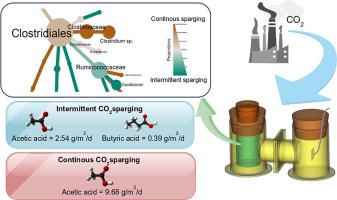Bioelectrochemistry ( IF 4.8 ) Pub Date : 2020-10-15 , DOI: 10.1016/j.bioelechem.2020.107686 Paolo Dessì 1 , Carlos Sánchez 1 , Simon Mills 1 , Francesco Giuseppe Cocco 2 , Marco Isipato 2 , Umer Z Ijaz 3 , Gavin Collins 1 , Piet N L Lens 1

|
Microbial electrosynthesis (MES) is a potential technology for CO2 recycling, but insufficient information is available on the microbial interactions underpinning electrochemically-assisted reactions. In this study, a MES reactor was operated for 225 days alternately with bicarbonate or CO2 as carbon source, under batch or continuous feeding regimens, to evaluate the response of the microbial communities, and their productivity, to dynamic operating conditions. A stable acetic acid production rate of 9.68 g m-2 d-1, and coulombic efficiency up to 40%, was achieved with continuous CO2 sparging, higher than the rates obtained with bicarbonate (0.94 g m-2 d-1) and CO2 under fed-batch conditions (2.54 g m-2 d-1). However, the highest butyric acid production rate (0.39 g m-2 d-1) was achieved with intermittent CO2 sparging. The microbial community analyses focused on differential amplicon sequence variants (ASVs), allowing detection of ASVs significantly different across consecutive samples. This analysis, combined with co-occurence network analysis, and cyclic voltammetry, indicated that hydrogen-mediated acetogenesis was carried out by Clostridium, Eubacterium and Acetobacterium, whereas Oscillibacter and Caproiciproducens were involved in butyric acid production. The cathodic community was spatially inhomogeneous, with potential electrotrophs, such as Sulfurospirillum and Desulfovibrio, most prevalent near the current collector. The abundance of Sulfurospirillum positively correlated with that of Acetobacterium, supporting the syntrophic metabolism of both organisms.
中文翻译:

不同CO 2喂养方式下羧酸的产生和电合成微生物群落的演变
微生物电合成(MES)是用于CO 2再循环的一项潜在技术,但是有关支撑电化学辅助反应的微生物相互作用的信息不足。在这项研究中,在间歇或连续进料方案下,以碳酸氢盐或CO 2为碳源的MES反应器交替运行225天,以评估微生物群落及其生产力对动态运行条件的响应。连续注入CO 2可获得稳定的乙酸产率9.68 gm -2 d -1,库仑效率高达40%,高于碳酸氢盐(0.94 gm -2 d -1))和CO 2在分批补料条件下(2.54 gm -2 d -1)。然而,间歇性CO 2喷射实现了最高的丁酸生产率(0.39 gm -2 d -1)。微生物群落分析侧重于差异扩增子序列变异体(ASV),可检测出连续样品之间显着不同的ASV。这项分析与共现网络分析和循环伏安法相结合,表明氢介导的产乙酸是由梭状芽孢杆菌,真细菌和醋杆菌进行的,而Oscillibacter和Caproiciproducens参与丁酸的生产。阴极群落在空间上是不均匀的,具有潜在的电养性,例如在集电器附近最普遍的Sulfurospirillum和Desulfovibrio。磺胺螺菌的丰度与醋杆菌的丰度呈正相关,支持两种生物的营养代谢。









































 京公网安备 11010802027423号
京公网安备 11010802027423号